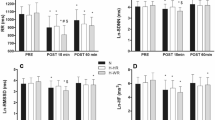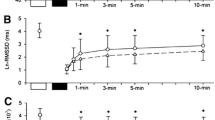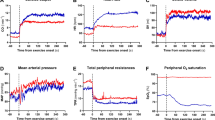Abstract
Purpose
This study investigated the effects of acute hypoxic exposure on post-exercise cardiac autonomic modulation following maximal cardiopulmonary exercise testing (CPET).
Methods
Thirteen healthy men performed CPET and recovery in normoxia (N) and normobaric hypoxia (H) (FiO2 = 13.4%, ≈ 3500 m). Post-exercise cardiac autonomic modulation was assessed during recovery (300 s) through the analysis of fast-phase and slow-phase heart rate recovery (HRR) and heart rate variability (HRV) indices.
Results
Both short-term, T30 (mean difference (MD) 60.0 s, 95% CI 18.2–101.8, p = 0.009, ES 1.01), and long-term, HRRt (MD 21.7 s, 95% CI 4.1–39.3, p = 0.020, ES 0.64), time constants of HRR were higher in H. Fast-phase (30 and 60 s) and slow-phase (300 s) HRR indices were reduced in H either when expressed in bpm or in percentage of HRpeak (p < 0.05). Chronotropic reserve recovery was lower in H than in N at 30 s (MD − 3.77%, 95% CI − 7.06 to − 0.49, p = 0.028, ES − 0.80) and at 60 s (MD − 7.23%, 95% CI − 11.45 to − 3.01, p = 0.003, ES − 0.81), but not at 300 s (p = 0.436). Concurrently, Ln-RMSSD was reduced in H at 60 and 90 s (p < 0.01) but not at other time points during recovery (p > 0.05).
Conclusions
Affected fast-phase, slow-phase HRR and HRV indices suggested delayed parasympathetic reactivation and sympathetic withdrawal after maximal exercise in hypoxia. However, a similar cardiac autonomic recovery was re-established within 5 min after exercise cessation. These findings have several implications in cardiac autonomic recovery interpretation and in HR assessment in response to high-intensity hypoxic exercise.

Similar content being viewed by others
Abbreviations
- ANOVA:
-
Analysis of variance
- ANS:
-
Autonomic nervous system
- CPET:
-
Cardiopulmonary exercise testing
- CRR:
-
Chronotropic reserve recovery
- EPOCt:
-
Excess of post-exercise oxygen consumption time constant
- EPOCMAG :
-
Excess of post-exercise oxygen consumption magnitude
- LF:
-
Low-frequency spectral power
- Ln:
-
Natural logarithm transformation
- HF:
-
High-frequency spectral power
- HR:
-
Heart rate
- HRR:
-
Heart rate recovery
- HRRt:
-
Long-term time constant of heart rate recovery
- HRV:
-
Heart rate variability
- RMSSD:
-
Root mean square of successive differences of R–R intervals
- T30:
-
Short-term time constant of heart rate recovery
- TP:
-
Total spectral power
References
Achten J, Jeukendrup AE (2003) Heart rate monitoring. Sport Med 33:517–538
Al Haddad H, Laursen PB, Chollet D et al (2010) Effect of cold or thermoneutral water immersion on post-exercise heart rate recovery and heart rate variability indices. Auton Neurosci 156:111–116. https://doi.org/10.1016/j.autneu.2010.03.017
Al Haddad H, Mendez-Villanueva A, Bourdon PC, Buchheit M (2012) Effect of acute hypoxia on post-exercise parasympathetic reactivation in healthy men. Front Physiol 3:289
Albouaini K, Egred M, Alahmar A, Wright DJ (2007) Cardiopulmonary exercise testing and its application. Postgrad Med J 83:675–682. https://doi.org/10.1136/hrt.2007.121558
Amann M, Kayser B (2009) Nervous system function during exercise in hypoxia. High Alt Med Biol 10:149–164. https://doi.org/10.1089/ham.2008.1105
Barak OF, Ovcin ZB, Jakovljevic DG et al (2011) Heart rate recovery after submaximal exercise in four different recovery protocols in male athletes and non-athletes. J Sports Sci Med 10:369–375
Bellenger CR, Fuller JT, Thomson RL et al (2016) Monitoring athletic training status through autonomic heart rate regulation: a systematic review and meta-analysis. Sport Med 46:1461–1486. https://doi.org/10.1007/s40279-016-0484-2
Borg E, Borg G (2002) A comparison of AME and CR100 for scaling perceived exertion. Acta Psychol (Amst) 109:157–175. https://doi.org/10.1016/S0001-6918(01)00055-5
Borresen J, Lambert MI (2008) Autonomic control of heart rate during and after exercise: measurements and implications for monitoring training status. Sports Med 38:633–646
Bourdillon N, Saugy J, Schmitt L et al (2017) Acute and chronic changes in baroreflex sensitivity in hypobaric vs. normobaric hypoxia. Eur J Appl Physiol 117:2401–2407. https://doi.org/10.1007/s00421-017-3726-6
Brocherie F, Girard O, Faiss R, Millet GP (2017) Effects of repeated-sprint training in hypoxia on sea-level performance: a meta-analysis. Sport Med 47:1651–1660. https://doi.org/10.1007/s40279-017-0685-3
Buchheit M, Richard R, Doutreleau S et al (2004) Effect of acute hypoxia on heart rate variability at rest and during exercise. Int J Sports Med 25:264–269
Buchheit M, Laursen PB, Ahmaidi S (2007a) Parasympathetic reactivation after repeated sprint exercise. AJP Hear Circ Physiol 293:H133–H141. https://doi.org/10.1152/ajpheart.00062.2007
Buchheit M, Papelier Y, Laursen PB, Ahmaidi S (2007b) Noninvasive assessment of cardiac parasympathetic function: postexercise heart rate recovery or heart rate variability? AJP Hear Circ Physiol 293:H8–H10. https://doi.org/10.1152/ajpheart.00335.2007
Buchheit M, Al Haddad H, Laursen PB, Ahmaidi S (2009a) Effect of body posture on postexercise parasympathetic reactivation in men. Exp Physiol 94:795–804. https://doi.org/10.1113/expphysiol.2009.048041
Buchheit M, Peiffer JJ, Abbiss CR, Laursen PB (2009b) Effect of cold water immersion on postexercise parasympathetic reactivation. Am J Physiol Circ Physiol 296:H421–H427. https://doi.org/10.1152/ajpheart.01017.2008
Calbet JAL, Boushel R, Rådegran G et al (2003) Determinants of maximal oxygen uptake in severe acute hypoxia. Am J Physiol Regul Integr Comp Physiol 284:R291–R303. https://doi.org/10.1152/ajpregu.00155.2002
Calbet JAL, Robach P, Lundby C (2009) The exercising heart at altitude. Cell Mol Life Sci 66:3601–3613. https://doi.org/10.1007/s00018-009-0148-6
Chapman RF, Karlsen T, Resaland GK et al (2014) Defining the “dose” of altitude training: how high to live for optimal sea level performance enhancement. J Appl Physiol 116:595–603. https://doi.org/10.1152/japplphysiol.00634.2013
Clark SA, Bourdon PC, Schmidt W et al (2007) The effect of acute simulated moderate altitude on power, performance and pacing strategies in well-trained cyclists. Eur J Appl Physiol 102:45–55. https://doi.org/10.1007/s00421-007-0554-0
Cottin F, Médigue C, Leprêtre P-M et al (2004) Heart rate variability during exercise performed below and above ventilatory threshold. Med Sci Sports Exerc 36:594–600
Cunha FA, Midgley AW, Gonçalves T et al (2015) Parasympathetic reactivation after maximal CPET depends on exercise modality and resting vagal activity in healthy men. Springerplus 4:100. https://doi.org/10.1186/s40064-015-0882-1
Danieli A, Lusa L, Potočnik N et al (2014) Resting heart rate variability and heart rate recovery after submaximal exercise. Clin Auton Res 24:53–61
de Oliveira Ottone V, de Castro Magalhães F, de Paula F et al (2014) The effect of different water immersion temperatures on post-exercise parasympathetic reactivation. PLoS One 9:e113730. https://doi.org/10.1371/journal.pone.0113730
Dinenno FA (2016) Skeletal muscle vasodilation during systemic hypoxia in humans. J Appl Physiol 120:216–225. https://doi.org/10.1152/japplphysiol.00256.2015
do Nascimento Salvador PC, de Aguiar RA, Teixeira AS et al (2016) Are the oxygen uptake and heart rate off-kinetics influenced by the intensity of prior exercise? Respir Physiol Neurobiol 230:60–67. https://doi.org/10.1016/j.resp.2016.05.007
Duffin J (2007) Measuring the ventilatory response to hypoxia. J Physiol 584:285–293. https://doi.org/10.1113/jphysiol.2007.138883
Esco MR, Olson MS, Williford HN et al (2010) The relationship between resting heart rate variability and heart rate recovery. Clin Auton Res 20:33–38. https://doi.org/10.1007/s10286-009-0033-2
Faiss R, Girard O, Millet GP (2013) Advancing hypoxic training in team sports: from intermittent hypoxic training to repeated sprint training in hypoxia. Br J Sports Med 47:i45–i50. https://doi.org/10.1136/bjsports-2013-092741
Favret F, Richalet J-P (2007) Exercise and hypoxia: the role of the autonomic nervous system. Respir Physiol Neurobiol 158:280–286. https://doi.org/10.1016/j.resp.2007.04.001
Fisher JP (2015) Cardiac autonomic regulation during hypoxic exercise. Am J Physiol Hear Circ Physiol 308:H1474–H1475. https://doi.org/10.1152/ajpheart.00311.2015
Gaston A-F, Durand F, Roca E et al (2016) Exercise-induced hypoxaemia developed at sea-level influences responses to exercise at moderate altitude. PLoS One 11:e0161819. https://doi.org/10.1371/journal.pone.0161819
Giles D, Kelly J, Draper N (2016) Alterations in autonomic cardiac modulation in response to normobaric hypoxia. Eur J Sport Sci 16:1023–1031
Girard O, Malatesta D, Millet GP (2017) Walking in hypoxia: an efficient treatment to lessen mechanical constraints and improve health in obese individuals? Front Physiol 8:73. https://doi.org/10.3389/fphys.2017.00073
Goldberger JJ, Le FK, Lahiri M et al (2006) Assessment of parasympathetic reactivation after exercise. AJP Hear Circ Physiol 290:H2446–H2452. https://doi.org/10.1152/ajpheart.01118.2005
Goodwin ML, Harris JE, Herna¡ndez A, Gladden LB (2007) Blood lactate measurements and analysis during exercise: a guide for clinicians. J Diabetes Sci Technol 1:558–569
Grataloup O, Busso T, Castells J et al (2007) Evidence of decrease in peak heart rate in acute hypoxia: effect of exercise-induced arterial hypoxemia. Int J Sports Med 28:181–185. https://doi.org/10.1055/s-2006-924216
Hainsworth R, Drinkhill MJ, Rivera-Chira M (2007) The autonomic nervous system at high altitude. Clin Auton Res 17:13–19. https://doi.org/10.1007/s10286-006-0395-7
Hopkins WG, Marshall SW, Batterham AM, Hanin J (2009) Progressive statistics for studies in sports medicine and exercise science. Med Sci Sport Exerc 41:3–13. https://doi.org/10.1249/MSS.0b013e31818cb278
Imai K, Sato H, Hori M et al (1994) Vagally mediated heart rate recovery after exercise is accelerated in athletes but blunted in patients with chronic heart failure. J Am Coll Cardiol 24:1529–1535
Iwasaki K, Ogawa Y, Aoki K et al (2006) Cardiovascular regulation response to hypoxia during stepwise decreases from 21 to 15% inhaled oxygen. Aviat Space Environ Med 77:1015–1019
Kuipers H, Verstappen FT, Keizer HA, Geurten P, Van Kranenburg G (1985) Variability of aerobic performance in the laboratory and its physiologic correlates. Int J Sports Med 6(04):197–201
Lizamore CA, Hamlin MJ (2017) The use of simulated altitude techniques for beneficial cardiovascular health outcomes in nonathletic, sedentary, and clinical populations: a literature review. High Alt Med Biol ham. https://doi.org/10.1089/ham.2017.0050
Lundby C, Saltin B, van Hall G (2000) The “lactate paradox”, evidence for a transient change in the course of acclimatization to severe hypoxia in lowlanders. Acta Physiol Scand 170:265–269. https://doi.org/10.1046/j.1365-201x.2000.00785.x
Malik M (1996) Heart rate variability. Ann Noninvasive Electrocardiol 1:151–181
Mann TN, Webster C, Lamberts RP, Lambert MI (2014) Effect of exercise intensity on post-exercise oxygen consumption and heart rate recovery. Eur J Appl Physiol 114:1809–1820. https://doi.org/10.1007/s00421-014-2907-9
Michael S, Jay O, Halaki M et al (2016) Submaximal exercise intensity modulates acute post-exercise heart rate variability. Eur J Appl Physiol 116:697–706
Michael S, Graham KS, Davis GM (2017a) Cardiac autonomic responses during exercise and post-exercise recovery using heart rate variability and systolic time intervals—a review. Front Physiol 8:301. https://doi.org/10.3389/fphys.2017.00301
Michael S, Jay O, Graham KS, Davis GM (2017b) Longer exercise duration delays post-exercise recovery of cardiac parasympathetic but not sympathetic indices. Eur J Appl Physiol 117:1897–1906. https://doi.org/10.1007/s00421-017-3673-2
Michael S, Jay O, Graham KS, Davis GM (2018) Influence of exercise modality on cardiac parasympathetic and sympathetic indices during post-exercise recovery. J Sci Med Sport. https://doi.org/10.1016/J.JSAMS.2018.01.015
Millet GP, Roels B, Schmitt L et al (2010) Combining hypoxic methods for peak performance. Sport Med 40:1–25. https://doi.org/10.2165/11317920-000000000-00000
Millet GP, Debevec T, Brocherie F et al (2016) Therapeutic use of exercising in hypoxia: promises and limitations. Front Physiol 7:224. https://doi.org/10.3389/fphys.2016.00224
Molina GE, Fontana KE, Porto LGG, Junqueira LF (2016) Post-exercise heart-rate recovery correlates to resting heart-rate variability in healthy men. Clin Auton Res 26:415–421
Mollard P, Woorons X, Letournel M et al (2007a) Role of maximal heart rate and arterial O2 saturation on the decrement of VO2max in moderate acute hypoxia in trained and untrained men. Int J Sports Med 28:186–192. https://doi.org/10.1055/s-2006-924215
Mollard P, Woorons X, Letournel M et al (2007b) Determinants of maximal oxygen uptake in moderate acute hypoxia in endurance athletes. Eur J Appl Physiol 100:663–673. https://doi.org/10.1007/s00421-007-0457-0
Nobrega ACL, O’Leary D, Silva BM et al (2014) Neural regulation of cardiovascular response to exercise: role of central command and peripheral afferents. Biomed Res Int 2014:1–20. https://doi.org/10.1155/2014/478965
Ofner M, Wonisch M, Frei M et al (2014) Influence of acute normobaric hypoxia on physiological variables and lactate turn point determination in trained men. J Sports Sci Med 13:774–781
Oliveira ALMB, Rohan P, de A, Gonçalves TR, et al (2017) Effects of hypoxia on heart rate variability in healthy individuals: a systematic review. Int J Cardiovasc Sci 30:251–261. https://doi.org/10.5935/2359-4802.20170035
Pecanha T, Bartels R, Brito LC et al (2017) Methods of assessment of the post-exercise cardiac autonomic recovery: a methodological review. Int J Cardiol 227:795–802
Peçanha T, de Brito LC, Fecchio RY et al (2016) Metaboreflex activation delays heart rate recovery after aerobic exercise in never-treated hypertensive men. J Physiol 594:6211–6223. https://doi.org/10.1113/JP272851
Perini R, Veicsteinas A (2003) Heart rate variability and autonomic activity at rest and during exercise in various physiological conditions. Eur J Appl Physiol 90:317–325
Qiu S, Cai X, Sun Z et al (2017) Heart rate recovery and risk of cardiovascular events and all-cause mortality: a meta-analysis of prospective cohort studies. J Am Heart Assoc 6:e005505. https://doi.org/10.1161/JAHA.117.005505
Robergs RA, Dwyer D, Astorino T (2010) Recommendations for improved data processing from expired gas analysis indirect calorimetry. Sports Med 40(2):95–111
Romero SA, Minson CT, Halliwill JR (2017) The cardiovascular system after exercise. J Appl Physiol 122:925–932. https://doi.org/10.1152/japplphysiol.00802.2016
Schmitt L, Hellard P, Millet GP et al (2006) Heart rate variability and performance at two different altitudes in well-trained swimmers. Int J Sports Med 27:226–231
Seiler S, Haugen O, Kuffel E (2007) Autonomic recovery after exercise in trained athletes: Intensity and duration effects. Med Sci Sports Exerc 39:1366–1373. https://doi.org/10.1249/mss.0b013e318060f17d
Siebenmann C, Rasmussen P, Sørensen H et al (2015) Hypoxia increases exercise heart rate despite combined inhibition of β-adrenergic and muscarinic receptors. Am J Physiol Hear Circ Physiol 308:H1540–H1546. https://doi.org/10.1152/ajpheart.00861.2014
Somers VK, Mark AL, Zavala DC, Abboud FM (1989) Influence of ventilation and hypocapnia on sympathetic nerve responses to hypoxia in normal humans. J Appl Physiol 67(5):2095–100
Task Force of the European Society of C (1996) Heart rate variability standards of measurement, physiological interpretation, and clinical use. Eur Hear J 17:354–381
Terziotti P, Schena F, Gulli G, Cevese A (2001) Post-exercise recovery of autonomic cardiovascular control: a study by spectrum and cross-spectrum analysis in humans. Eur J Appl Physiol 84:187–194. https://doi.org/10.1007/s004210170003
Thayer JF, Ahs F, Fredrikson M et al (2012) A meta-analysis of heart rate variability and neuroimaging studies: implications for heart rate variability as a marker of stress and health. Neurosci Biobehav Rev 36:747–756. https://doi.org/10.1016/j.neubiorev.2011.11.009
van Hall G (2007) Counterpoint: the lactate paradox does not occur during exercise at high altitude. J Appl Physiol 102:2399–2401. https://doi.org/10.1152/japplphysiol.00039a.2007
Ward SA, Grocott MPW, Levett DZH (2017) Exercise testing, supplemental oxygen, and hypoxia. Ann Am Thorac Soc 14:S140–S148. https://doi.org/10.1513/AnnalsATS.201701-043OT
Wehrlin JP, Hallén J (2006) Linear decrease in VO2max and performance with increasing altitude in endurance athletes. Eur J Appl Physiol 96:404–412. https://doi.org/10.1007/s00421-005-0081-9
West JB (2007) Point: the lactate paradox does/does not occur during exercise at high altitude. J Appl Physiol 102:2398–2399. https://doi.org/10.1152/japplphysiol.00039.2007
Yamamoto Y, Hoshikawa Y, Miyashita M (1996) Effects of acute exposure to simulated altitude on heart rate variability during exercise. J Appl Physiol 81:1223–1229
Zupet P, Princi T, Finderle Z (2009) Effect of hypobaric hypoxia on heart rate variability during exercise: a pilot field study. Eur J Appl Physiol 107:345–350
Acknowledgements
The authors would like to thank the subjects for their time and enthusiasm. The research was supported by the Ministry for Higher education, Research Innovation (France) and Tomsk Polytechnic University Competitiveness Enhancement Program Grant (Project No. ВИУ-ИСГТ-108/2017 - TPU CEP-HSTI-108/2017).
Author information
Authors and Affiliations
Contributions
AF, AS, SS, LB, LM and BP participated in study conception and design. AF, AS and SS participated in data acquisition. AF, FSt, GB and AZ participated in data analysis. AF and LM were responsible for data interpretation. AF, AS, SS, GB, AZ, LM and BP contributed to the draft of the paper. AF, AS, SS, GB, AZ, FSc, LM and BP critically reviewed the manuscript. All authors approved the final version of the manuscript.
Corresponding author
Ethics declarations
Conflict of interest
The authors declare that they have no conflict of interest.
Additional information
Communicated by I. Mark Olfert.
Electronic supplementary material
Below is the link to the electronic supplementary material.
Rights and permissions
About this article
Cite this article
Fornasiero, A., Savoldelli, A., Skafidas, S. et al. Delayed parasympathetic reactivation and sympathetic withdrawal following maximal cardiopulmonary exercise testing (CPET) in hypoxia. Eur J Appl Physiol 118, 2189–2201 (2018). https://doi.org/10.1007/s00421-018-3945-5
Received:
Accepted:
Published:
Issue Date:
DOI: https://doi.org/10.1007/s00421-018-3945-5




